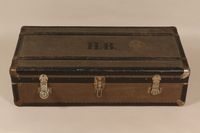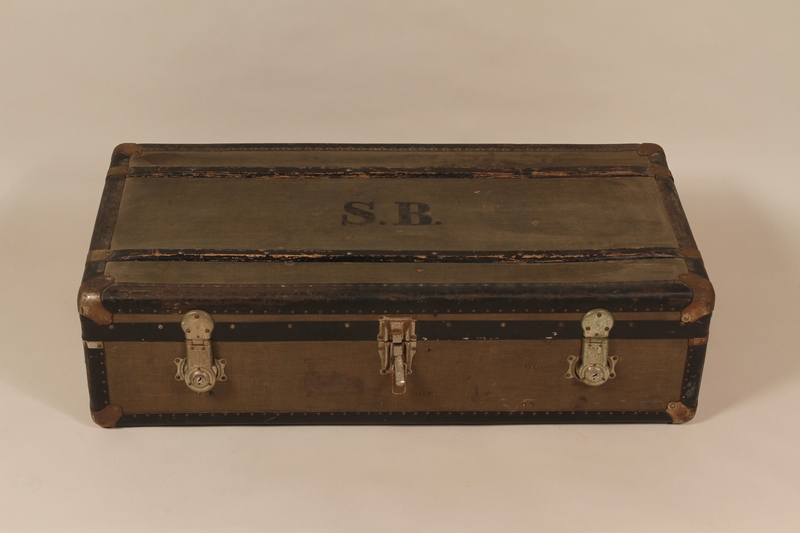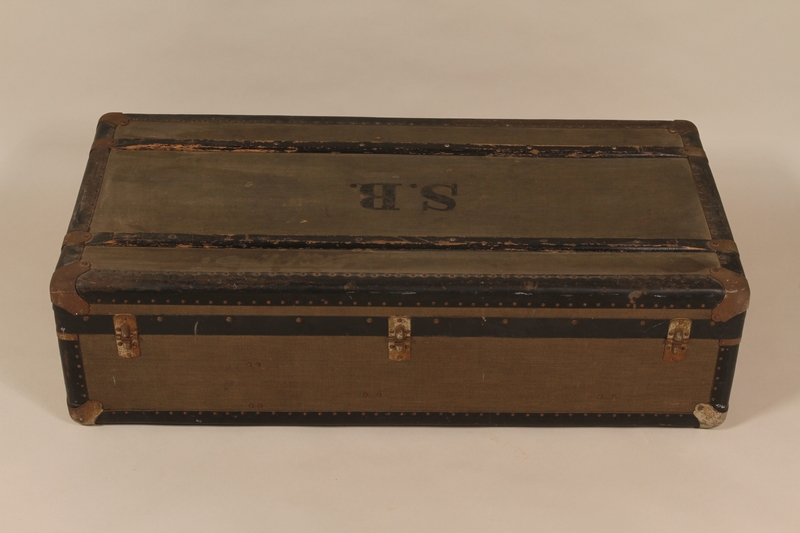Overview
- Brief Narrative
- Large trunk used by Sophie Bernhard when she left Berlin, Germany, for Havana, Cuba, in March 1939. Due to German emigration laws, Sophie and her husband, Hans, were only allowed to bring one suitcase per person. In November 1938, Hans was notified by the German government that he would no longer be able to operate his wholesale textile business because he was Jewish. Hans and Sophie sailed from Hamburg on the MS Orinoco on March 28, 1939. The Orinoco was the last ship allowed to unload refugee passengers from Europe in Havana. In March 1940, Hans and Sophie emigrated to the United States.
- Date
-
emigration:
1939 March 28
- Geography
-
en route:
MS Orinoco (Ship);
Havana (Cuba)
- Credit Line
- United States Holocaust Memorial Museum Collection, Gift of the Estate of Henry Bernhard
- Contributor
-
Subject:
Henry J. Bernhard
Subject: Sophie C. Bernhard
- Biography
-
Hans John Bernhard was born in Berlin, Germany, on February 23, 1906, to Auguen and Marta Reich Bernhard. Auguen was born in Berlin in 1878. Hans owned a wholesale textile business. He was very active in sports and had belonged to a Jewish sports club in Berlin since the 1920s. In 1933, he married Sophie Charlotte Schlesinger, who had been born in Berlin on November 27, 1907. She worked as a window dresser in a clothing store.
After Hitler was appointed Chancellor in 1933, anti-Jewish legislation and restrictions became increasingly harsh. On November 12, 1938, Hans was notified that, as of January 1, 1939, he would no longer be able to operate a business in Germany because he was Jewish. Hans and Sophie decided to leave Germany and secured tickets for the MS Orinoco, set to sail from Hamburg to Havana, Cuba, on March 28, 1939. The day before their departure, the Nazi government changed the items that could be brought out of the country. They could only take one traveling trunk and there were strict limits on valuables. They had been planning to take their sterling silver flatware set, but now were allowed to take only one place setting per person. Their neighbor buried the remaining flatware in his yard. Their passports were stamped with the required J and included the required middle names Israel for men and Sarah for women. They arrived in Havana on April 16, and stayed in a boarding house operated by Polish Jews. The MS Orinoco was the last ship allowed to unload refugee passengers in Havana. The Bernhards lived off funds from Sophie’s sister who had emigrated to South Africa with her husband in 1936. On June 2, Hans and Sophie watched the MS St. Louis depart after the passengers were denied entry and the ship was ordered to leave Havana Bay.
On March 12, 1940, Hans and Sophie emigrated to the United States via the Eastern SS Lines. Hans Americanized his name to Henry. They arrived in Miami and were helped by the Jewish community. Sophie spoke English but Henry only spoke German. A couple from Columbus, Georgia, the Schwobs, offered to help relocate Henry and Sophie. Simon Schwob had been born on the German-French border and spoke German. Henry and Sophie moved to Columbus on March 28. Sophie worked in a women’s dress store and Henry worked in Simon’s textile factory. In 1941, Henry and Sophie had a son. Henry’s father, Auguen, age 78, passed away in 1943 in Chile. After the war ended in May 1945, they retrieved the sterling silver flatware that their neighbor had buried for them. Sophie, age 78, passed away on August 1, 1982. Henry, age 97, passed away on September 26, 2003.
Sophie Charlotte Schlesinger was born to a Jewish family in Berlin, Germany, on November 27, 1907. She had one sister. She worked as a window dresser in a clothing store. In 1933, she married Hans John Bernhard, who was born in Berlin on February 23, 1906. He owned a wholesale textile business. After Hitler was appointed Chancellor in 1933, anti-Jewish legislation and restrictions became increasingly harsh. On November 12, 1938, Hans was notified that, as of January 1, 1939, he would no longer be able to operate a business in Germany because he was Jewish. Hans and Sophie decided to leave Germany and secured tickets for the MS Orinoco, set to sail from Hamburg to Havana, Cuba, on March 28, 1939. The day before their departure, the German government changed the regulations on the amount of belongings that could be taken out of Germany. Sophie and Hans could take only one traveling trunk and there were strict limits on valuables. They had been planning to take their sterling silver flatware set, but now were allowed to take only one place setting per person. Their neighbor buried the remaining flatware in his yard. Their passports were stamped with the required J and included the required middle names Israel for men and Sarah for women. They arrived in Havana on April 16, and stayed in a boarding house operated by Polish Jews. The MS Orinoco was the last ship allowed to unload refugee passengers in Havana. The Bernhards lived off funds from Sophie’s sister who had emigrated to South Africa with her husband in 1936. On June 2, Hans and Sophie watched the MS St. Louis depart after the passengers were denied entry and the ship was ordered to leave Havana Bay.
On March 12, 1940, Hans and Sophie emigrated to the United States via the Eastern SS Lines. Hans Americanized his name to Henry. They arrived in Miami and were helped by the Jewish community. Sophie spoke English but Henry only spoke German. A couple from Columbus, Georgia, the Schwobs, offered to help relocate Henry and Sophie. Simon Schwob had been born on the German-French border and spoke German. Henry and Sophie moved to Columbus on March 28. Sophie worked in a women’s dress store and Henry worked in Simon’s textile factory. In 1941, Henry and Sophie had a son. Henry’s father, Auguen, age 78, passed away in 1943 in Chile. After the war ended in May 1945, they retrieved the sterling silver flatware that their neighbor had buried for them. Sophie, age 78, passed away on August 1, 1982. Henry, age 97, passed away on September 26, 2003.
Physical Details
- Classification
-
Containers
- Category
-
Luggage
- Object Type
-
Trunks (Luggage) (lcsh)
- Physical Description
- Large, long, flat rectangular trunk with a wooden frame covered in plastic treated cloth with a pattern of black dots on a light brown backing. Except for the front side, the exterior has turned dark green from use. All hardware is tarnished, silver colored metal. The exterior edges are reinforced with black plastic trim with rivets and corner clamps. Across the lid and base are 2 horizontal black wooden slats with slat clamps. The front center has a drawbolt latch flanked by key lock plates. The lid top has a large, stenciled monogram. The left and right sides have a center metal plate into which the lid inserts into base to seal the trunk. The left and right base sides have a brown leather handle inserted through a bracket. The lid is attached to the base by 3 flap hinges and is held open by a stay on the left interior. The interior is lined with stained, offwhite cloth. The base interior has 2 sets of light gray cloth belts and metal slots for a missing divider. The interior has a removable offwhite cloth lined wooden tray with cloth handles and 2 sets of light gray cloth belts.
- Dimensions
- overall: Height: 12.375 inches (31.433 cm) | Width: 43.500 inches (110.49 cm) | Depth: 22.000 inches (55.88 cm)
- Materials
- overall : wood, cloth, plastic, metal, paint
- Inscription
- exterior, lid top, stenciled, black paint : S.B.
Rights & Restrictions
- Conditions on Access
- No restrictions on access
- Conditions on Use
- No restrictions on use
Keywords & Subjects
- Topical Term
- Holocaust, Jewish (1939-1945)--Germany--Berlin--Personal narratives, Jewish. Jewish refugees--Cuba--Havana--Biography. Jewish refugees--United States--Biography. World War, 1939-1945--Refugees--Cuba--Personal, narratives. World War, 1939-1945--Refugees--United States--Personal narratives.
Administrative Notes
- Legal Status
- Permanent Collection
- Provenance
- The trunk was donated to the United States Holocaust Memorial Museum in 2004 by Judge Aaron Cohn, on behalf of the Estate of Henry Bernhard.
- Funding Note
- The cataloging of this artifact has been supported by a grant from the Conference on Jewish Material Claims Against Germany.
- Record last modified:
- 2022-08-22 16:18:59
- This page:
- https://collections.ushmm.org/search/catalog/irn515185
Download & Licensing
In-Person Research
- By Appointment
- Request 21 Days in Advance of Visit
- Plan a Research Visit
- Request to See This Object
Contact Us
Also in Henry and Sophie Bernhard collection
The collection consists of a camera, two travel trunks, documents, and a photograph relating to the experiences of Hans and Sophie Bernhard before and during the Holocaust when they emigrated from Berlin, Germany, to Havana, Cuba, and later in the United States after the Holocaust.
Date: 1936-1961

Large flat top trunk monogrammed HB used by a German Jewish refugee
Object
Large trunk used by Hans Bernhard when he left Berlin, Germany, for Havana, Cuba, in March 1939. Due to German emigration laws, Hans and his wife, Sophie, were only allowed to bring one suitcase per person. In November 1938, Hans was notified by the German government that he would no longer be able to operate his wholesale textile business because he was Jewish. Hans and Sophie sailed from Hamburg on the MS Orinoco on March 28, 1939. The Orinoco was the last ship allowed to unload refugee passengers from Europe in Havana. In March 1940, Hans and Sophie emigrated to the United States.
Hans and Sophie Bernhard papers
Document
The papers consist of documents, passports ("Reisepass"), a kennkarte, identification cards, and a photograph that record Hans (Henry) and Sophie Bernhard's immigration from Berlin, Germany, to the United States by way of Havana, Cuba. The Bernhards eventually settled in Columbus, GA.
Leica IIIa camera and brown leather case owned by a German Jewish refugee to Cuba
Object
Leica IIIa camera and brown leather cased purchased by Hans Bernhard in Berlin, Germany, prior to his emigration to Havana, Cuba, in March 1939. Hans purchased the camera with the intention to sell it if he ran short of funds, as there were strict limits on the amount of money Jews could take out of Germany. In November 1938, Hans was notified by the Nazi government that he would no longer be able to operate his textile wholesale business because he was Jewish. Hans and his wife, Sophie, sailed on the MS Orinoco from Hamburg on March 28, 1939. The Orinoco was the last ship allowed to unload refugee passengers from Europe in Havana. In March 1940, Hans and Sophie emigrated to the United States.





